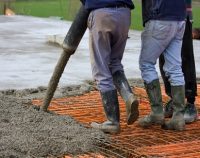Design of Heavy Duty Concrete Floor Slabs on Grade: 3 PDH
$18.00
This course describes the criteria for the design of concrete floor slabs on grade in buildings for heavy loads. Concrete floor slabs on grade are often subjected to heavy loads in buildings such as wall loads, stationary live loads and moving loads. The entire design procedure is based on a working stress concept. This course will provide the student with the criteria needed to design concrete floor slabs on grade subjected to heavy loads. Design examples are shown to aid in understanding the course material.
SPECIFIC KNOWLEDGE OR SKILL OBTAINED
This course teaches the following specific knowledge and skills:
- The steps required to design a heavy duty concrete floor slab
- How to determine floor slab requirements for wall loads, stationary wall loads and moving loads
- How to investigate the subgrade and environmental conditions relevant to the design
- How to determine the modulus of subgrade reaction for various soils
CERTIFICATE OF COMPLETION
You will be able to immediately print a certificate of completion after passing a 15 question multiple-choice quiz. The quiz can be retaken unlimited times until a passing grade of 70% or better is earned. This course satisfies 3 professional development hours (PDH) of continuing education.
Related Courses
Foundations in Expansive Soils: 6 PDH
$36.00 Add to cartThis course presents guidance and information for the geotechnical investigation necessary for the selection and design of foundations for heavy and light buildings constructed in expansive clay soil areas. The information in this course is generally applicable to many types of structures such as residences, warehouses, and multi-story buildings. Emphasis is given to the maintenance of an environment that encourages constant moisture conditions in the foundation soils during and following construction. Special attention must always be given to specific requirements of the structure such as limitations on allowable differential movement.Instructor: Raymond Bosek, PEThis course presents guidance and information for the geotechnical investigation necessary for the selection and design of foundations for heavy and light buildings constructed in expansive clay soil areas. The information in this course is generally applicable to many types of structures such as residences, warehouses, and multi-story buildings. Emphasis is given to the maintenance of an environment that encourages constant moisture conditions in the foundation soils during and following construction. Special attention must always be given to specific requirements of the structure such as limitations on allowable differential movement.
SPECIFIC KNOWLEDGE OR SKILL OBTAINED
This course teaches the following specific knowledge and skills:
- Guidelines of the geotechnical investigation and analysis
- Field exploration
- Laboratory investigations
- Methodology for prediction of volume changes
- Selection of the type of foundation
- Structural details of design procedures provided for reference
- Methods of minimizing foundation movement
- Construction techniques and inspection
Remedial repair of damaged structures
CERTIFICATE OF COMPLETION
You will be able to immediately print a certificate of completion after passing a 20 question multiple-choice quiz. The quiz can be retaken unlimited times until a passing grade of 70% or better is earned. This course satisfies 6 professional development hours (PDH) of continuing education.
Preview CourseClick “Preview Course” to View Prior to PurchaseClick “Add to Cart” to Purchase and Access QuizSeismic Restraints for Mechanical Equipment: 4 PDH
$24.00 Add to cartIn this online course a student will understand the methods and procedures to restraint various types of mechanical equipment for seismic loads. Instructor: Seth Grablow, PESPECIFIC KNOWLEDGE OR SKILL OBTAINED
This course teaches the following specific knowledge and skills:
- Discuss the various types of mechanical equipment which require seismic restraints
- Explain rigid & vibration isolated floor mounting
- Discuss roof mounting seismic restraining
- Explain suspended & wall mounting procedures
- Explain the various types and selection of anchors
- Discuss special cases equipment & methods
CERTIFICATE OF COMPLETION
You will be able to immediately print a certificate of completion after passing a twenty (20) question multiple-choice quiz. The quiz can be retaken unlimited times until a passing grade of 70% or better is earned. This course satisfies four (4) continuing education hours (CEH)/professional development hours (PDH) of continuing education.
Preview CourseClick” Preview Course” to View Prior to PurchaseClick “Add to Cart” to Purchase and Access Quiz




